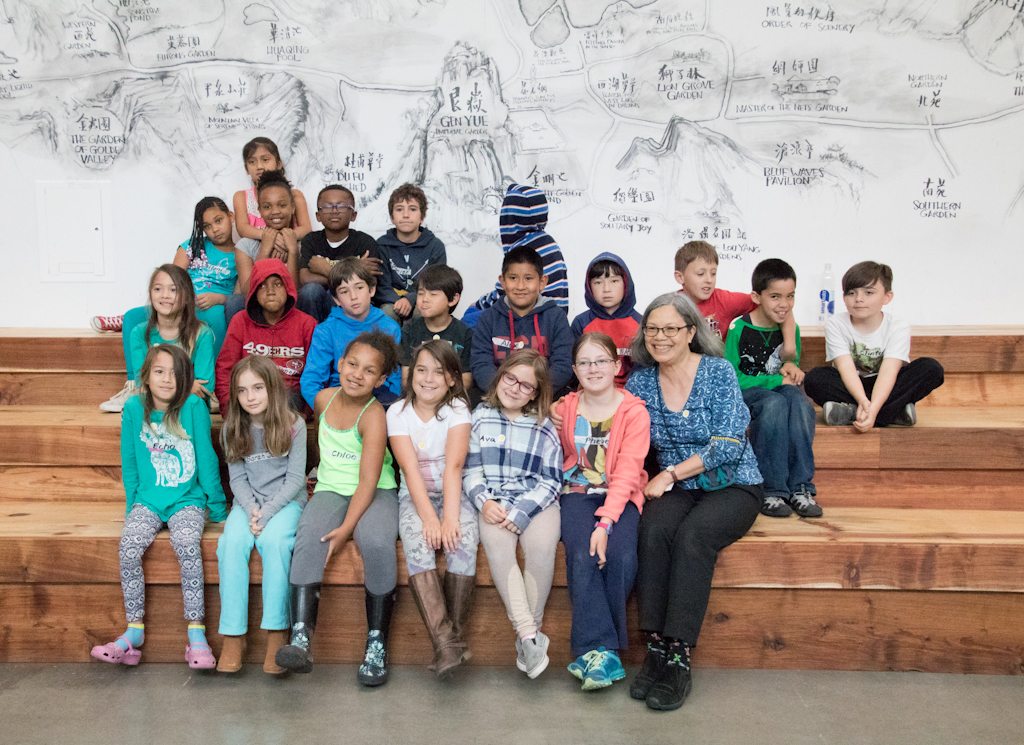 The inaugural exhibition at the new Berkeley Art Museum and Pacific Film Archive (BAMPFA) is “Architecture of Life,” which explores the ways that architecture (“as concept, metaphor, and practice”) illuminates different aspects of life. Featuring over 200 works of art in a range of media, including scientific and architectural drawings, the exhibit is the perfect kickoff for the museum’s beautiful new building.
The inaugural exhibition at the new Berkeley Art Museum and Pacific Film Archive (BAMPFA) is “Architecture of Life,” which explores the ways that architecture (“as concept, metaphor, and practice”) illuminates different aspects of life. Featuring over 200 works of art in a range of media, including scientific and architectural drawings, the exhibit is the perfect kickoff for the museum’s beautiful new building.
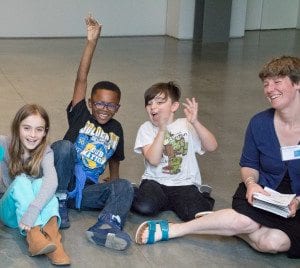 BAMPFA has always been dedicated to educational programming, and this semester they invited second and third graders from Berkeley and West Contra Costa public schools to visit the Architecture of Life exhibit with a grade-level tour. Admission and transportation were even free for teachers and students!
BAMPFA has always been dedicated to educational programming, and this semester they invited second and third graders from Berkeley and West Contra Costa public schools to visit the Architecture of Life exhibit with a grade-level tour. Admission and transportation were even free for teachers and students!
As fiscal sponsors for the tour transportation, we were pleased to tag along for a couple Friday morning tours. The program is an hour and 15 minutes, but the teaching artist tour guides were able to pack in a ton of information into that time.
Starting things off, students circled around to discuss the meaning of the word “architecture.” They suggested, “designing buildings,” “making something on the computer and building it in real life,” and using “materials like metal, wood, concrete, glass, paper, and paint.” This provided the framework for the full tour: architecture relies on collaboration, a play between 2D and 3D, and a certain preoccupation with environment.
 The first artwork students discussed was Ruth Asawa’s untitled woven sculptures. With each new piece, students were given time to observe and note their observations aloud. Students suggested Asawa’s piece was made out of string or chicken wire, and they guessed how many pieces of wire might have been used to make the sculptures (true answer: 1 for most of them!). Then each person was given a piece of wire and had the opportunity to make his or her own mini sculpture.
The first artwork students discussed was Ruth Asawa’s untitled woven sculptures. With each new piece, students were given time to observe and note their observations aloud. Students suggested Asawa’s piece was made out of string or chicken wire, and they guessed how many pieces of wire might have been used to make the sculptures (true answer: 1 for most of them!). Then each person was given a piece of wire and had the opportunity to make his or her own mini sculpture.
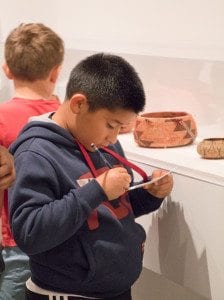 Next, students went on a “gallery walk” to silently observe tribal baskets, paintings, and bowls. This section’s discussion centered on Mbuti Barkcloth Drawings, which map the moods of the forest for special occasions. The Mbuti (an indigenous pygmy group in Africa) used charcoal and juices to draw patterns resembling constellation maps. Students were given sketchbooks and encouraged to map the mood of one of their favorite places. Many also attempted to replicate Asawa’s sculptures in their notebooks.
Next, students went on a “gallery walk” to silently observe tribal baskets, paintings, and bowls. This section’s discussion centered on Mbuti Barkcloth Drawings, which map the moods of the forest for special occasions. The Mbuti (an indigenous pygmy group in Africa) used charcoal and juices to draw patterns resembling constellation maps. Students were given sketchbooks and encouraged to map the mood of one of their favorite places. Many also attempted to replicate Asawa’s sculptures in their notebooks.
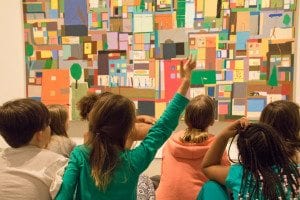 “Cityscape with House & Gray Energy” by Chris Johanson elicited observations about environments, pitching urban against rural against emptiness. Students noticed “some people are polluting,” and they observed that there were lines connecting individuals with speech bubbles. About an hour into the tour, the third graders were beginning to get restless. Our teaching artist anticipated this and facilitated a wild activity: a symphony of city sounds. One group was assigned to make human noises, another the machines, and the last group made nature noises. The teaching artist conducted the groups like an orchestra, directing them to get louder or (more often) softer.
“Cityscape with House & Gray Energy” by Chris Johanson elicited observations about environments, pitching urban against rural against emptiness. Students noticed “some people are polluting,” and they observed that there were lines connecting individuals with speech bubbles. About an hour into the tour, the third graders were beginning to get restless. Our teaching artist anticipated this and facilitated a wild activity: a symphony of city sounds. One group was assigned to make human noises, another the machines, and the last group made nature noises. The teaching artist conducted the groups like an orchestra, directing them to get louder or (more often) softer.
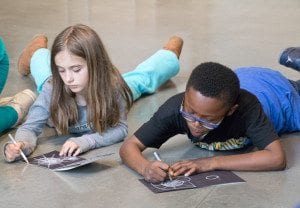 For the final project, groups were taken in to a small, black room featuring Plexiglas boxes lit from below. Tomás Saraceno’s spider webs are the ultimate collaboration between humans and nature. The process of making the art was simple and beautiful: place a spider in each box and allow it to weave its web. Then remove it and put a different spider in the same box to build upon the other spider’s work. In the end, each box holds several spiders’ intricate webs.
For the final project, groups were taken in to a small, black room featuring Plexiglas boxes lit from below. Tomás Saraceno’s spider webs are the ultimate collaboration between humans and nature. The process of making the art was simple and beautiful: place a spider in each box and allow it to weave its web. Then remove it and put a different spider in the same box to build upon the other spider’s work. In the end, each box holds several spiders’ intricate webs.
Groups alternated going into visit Saraceno’s work and working on their own collaborative spider web drawings. Wielding a white pencil and black construction paper, each student began drawing a spider web. After a minute, the papers were passed to the right for the next student to build upon.
Students visibly loved their fieldtrip to BAMPFA. When asked who would be bringing their families back for another visit, every kid raised his or her hand. Especially once they learned that every child 18 and under plus an accompanying adult gets into the museum for free.
Be sure to check out all of BAMPFA’s family programming here.

